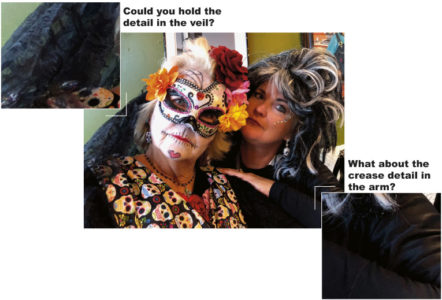Does this picture scare you? Could you print this picture with your inkjet and media combination without plugging up the rich black detail? Could you control the mid to ¾ tones detail in the rich black areas?
 Producing quality rich blacks and image details printed with inkjet can become a scary task. Black details can be hard to control as the ink is a wet-on-wet process regardless of the ink chemistry you may jet. Inkjet is especially hard if using highly porous media as the ink will dive into the media structure and spread in the X,Y and Z direction plugging finite detail.
Producing quality rich blacks and image details printed with inkjet can become a scary task. Black details can be hard to control as the ink is a wet-on-wet process regardless of the ink chemistry you may jet. Inkjet is especially hard if using highly porous media as the ink will dive into the media structure and spread in the X,Y and Z direction plugging finite detail.
Changing to a higher hold out media with little porosity can help, but other issues can occur. When aqueous or uv ink sits higher on the media surface, it requires faster drying so the ink does not have time to dwell on the surface. When ink dwells, it causes the jetted ink to react faster to the media’s surface tension and repel or spread into the other colors causing bleed, coalescence (aqueous), wicking, stacking and curing (uv) issues. Each of these defects will greatly reduce your image detail.
Reducing your overall TAC (ink limiting) can help with this process regardless of ink type, but reducing all colors limits your chroma and black depth you can achieve. Media, pretreatment and dry speed all affect the way ink reacts to the media’s surface and normally, you will find that certain colors give you the most problems based on their chemistry and the timing of when they are jetted to drying or curing.
Understanding which inks/combinations are causing the issues is critical. If you only have a couple of colors which dive, bleed, wick or coalesce when combined, doesn’t make sense to identify and only limit those colors? Why lessen the chroma of colors which are not a problem.
Understanding how your colors dry (above or below the sheet) and react when combined can help understand what printed ink values are compatible and keep the chroma and detail needed when printing rich black detail.
It’s a step by step process which can be adapted to any type of inkjet chemistry for commercial paper/label or industrial non-porous media.
Rich blacks and halftone details don’t have to be scary. Inkjet Insight offers ink compatibility process training to help your process achieve the highest print quality for your inkjet process.
Happy Halloween
Mary Schilling
